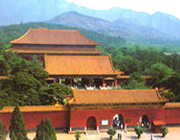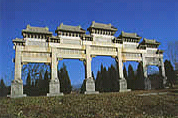The Ming Dynasty lasted from 1368 to 1644. The first Ming emperor had his tomb built in Nanjing, the town which he had chosen for his capital. The third emperor, Emperor Yongle was aware that a peaceful northern frontier was of great importance to the Ming Palace, so he chose this valley to build his tomb. All his successors followed his example and had their tombs built here, except one who was dethroned and buried in the western suburb.
The tombs are located about 50 kilometers to the north of Beijing.  They are scattered over a basin approximately 40 square kilometers in area, screened by mountains on three sides and open to the Beijing Plain in the south. The road leading to the tombs is guarded by the Tiger Hill on the left and the Dragon Hill on the right. It was a forbidden ground except for those who were officially in charge of its upkeep. It was not allowed to cultivate land, cut wood or to take stones from here. No one could enter it on horseback, even the emperor himself had to dismount at the gate.
They are scattered over a basin approximately 40 square kilometers in area, screened by mountains on three sides and open to the Beijing Plain in the south. The road leading to the tombs is guarded by the Tiger Hill on the left and the Dragon Hill on the right. It was a forbidden ground except for those who were officially in charge of its upkeep. It was not allowed to cultivate land, cut wood or to take stones from here. No one could enter it on horseback, even the emperor himself had to dismount at the gate.
Sacred Way Each tomb is located at the foot of a separate hill and is linked with the other tombs by a road called the Sacred Way. The stone archway at the southern end of the Sacred Way, built in 1540, is 14 metres high and 19 metres wide, and is decorated with designs of clouds, waves and divine animals.
Memorian Arch The Memorian Arch, which was built of white marble, was erected in 1540. It is 12 metres high and 31 metres wide, and has 5 arches supported by 6 pillars with beautiful bas-relief carvings of lions, dragons and lotus flowers. Double lintels link the six pillars. The roofing is made of round marble tiles, with upturned corners. "The way of the spirit" used to pass beneath the Memorial Arch. Underground Palace of Dingling Dingling Tomb is the representative royal tomb of the Ming Dynasty tombs. Dingling is the tomb of the thirteenth Emperor Shenzong (Zhuyijun) of the Ming Dynasty and his two Queens, Xiaoduan and Xiaojing. It is the only one of the Ming Tombs to have been excavated so far. Excavation started in 1956, 2 years later the museum of the Underground Palace was set up. The burial objects cleared out of the underground palace came to more than 3000.
The Underground Palace of Ding Ling consisted of the ante-chamber, the middle-chamber with 2 annexes chambers on each side, and the back-chamber. The Underground Palace was entirely built of stone, with vaulted ceilings and no columns or beams.
Stone animals and statues  These animals and statues all date from the 15th century. The avenue starts with two columns, called wangzhu in Chinese, one on each side. They are hexagonal, carved with a cloud design, and the top is shaped like a round cylinder. The animals are lions, xiezhi, camels, elephants, qilin and horses, one kneeling and the other standing, twelve on each side and twenty-four in all. Xiezhi was a mythical beast or the feline family, said to be able to distinguish right and wrong. Qilin was a sort of imaginary animal with a scaly body, a cows tail, deers hooves and horns on its head.
These animals and statues all date from the 15th century. The avenue starts with two columns, called wangzhu in Chinese, one on each side. They are hexagonal, carved with a cloud design, and the top is shaped like a round cylinder. The animals are lions, xiezhi, camels, elephants, qilin and horses, one kneeling and the other standing, twelve on each side and twenty-four in all. Xiezhi was a mythical beast or the feline family, said to be able to distinguish right and wrong. Qilin was a sort of imaginary animal with a scaly body, a cows tail, deers hooves and horns on its head.
In 1956, the tomb was opened. It was the first time that an imperial tomb was excavated in China in a scientific way. Dingling is now a museum made up of three sections: the Underground Palace and two exhibition rooms. The objects on display are mostly originals. The trip to the Ming Tombs certainly gives us a better understanding of the Ming Dynasty art, the tomb structure and the Emperors extravagance in building the tomb.